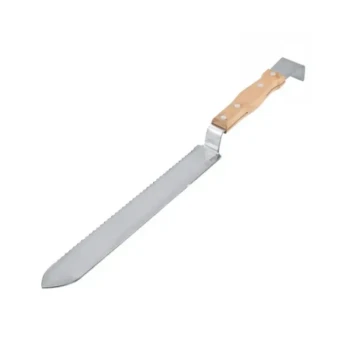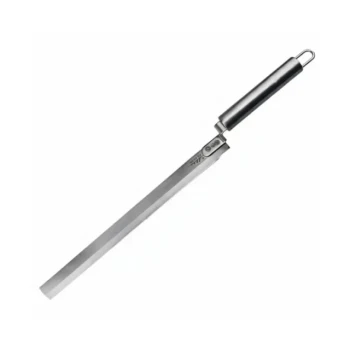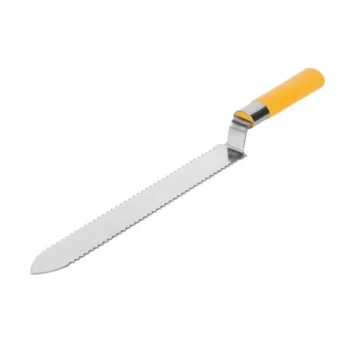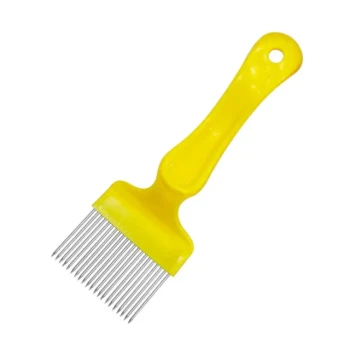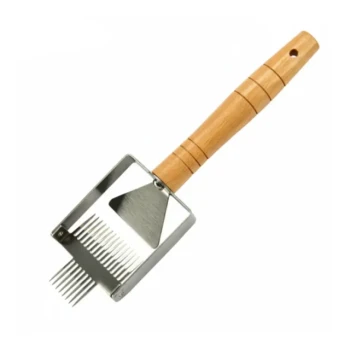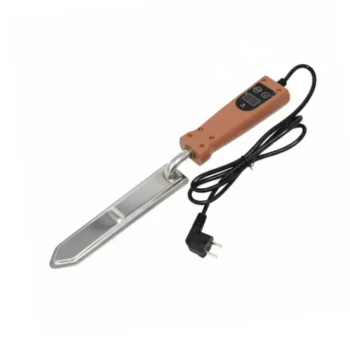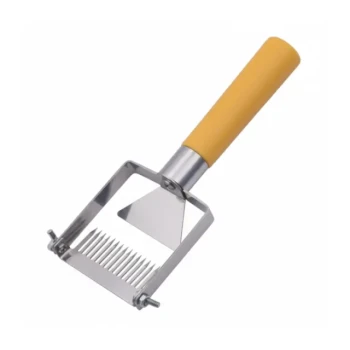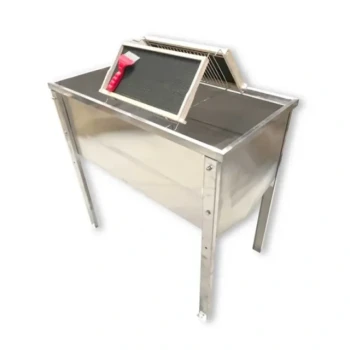For optimal performance, most electric honey knives are factory-calibrated to operate at a surface temperature of approximately 290°F (143°C). This high heat is specifically designed to melt beeswax for a clean cut. While the knife gets very hot, the brief contact time during the uncapping process prevents damage to the honey itself.
The core principle is simple: the knife's high temperature is for the wax, not the honey. Your speed and technique are what protect the honey's quality by ensuring contact is minimal.

Why Such a High Temperature?
The temperature of a honey knife is a careful balance between the melting point of beeswax and the heat sensitivity of honey. Understanding this balance is key to effective uncapping.
The Goal: Instantly Melting Wax
Beeswax has a melting point of around 144-147°F (62-64°C). To uncap a frame cleanly without tearing the comb, the knife must be significantly hotter than this.
A temperature of 290°F (143°C) provides enough thermal energy to slice through the wax cappings instantly, resulting in a smooth surface and minimal drag.
The Role of Speed and Technique
The high temperature is effective only because the knife is in motion. A quick, fluid pass across the honeycomb ensures the heat is applied to the wax for only a fraction of a second.
This brief contact time is not long enough to transfer significant heat into the bulk of the honey within the cells, thereby preserving its quality.
The Critical Risk: Damaging the Honey
While the knife is designed to be hot, overheating the honey is a legitimate concern that can degrade its quality.
How Heat Affects Honey
To be considered "raw," honey should generally not be heated above 104°F (40°C). Excessive heat destroys the natural enzymes and delicate aromatic compounds that give raw honey its unique character and health benefits.
If a hot knife were to linger on the frame, it could easily scorch the honey it touches, darkening its color and creating off-flavors.
Signs of an Overheated Knife or Poor Technique
You will know if the heat is negatively affecting the honey. Telltale signs include a sizzling sound as the knife passes over the comb or visible darkening and caramelization of the honey left on the uncapped surface.
Understanding Device Calibration and Operation
Most quality honey knives are not designed for user adjustment, and for good reason. They are precisely calibrated by the manufacturer.
The Initial Preheating Period
When you first turn on an electric knife, it may briefly exceed its target temperature before settling into its stable operating equilibrium of around 290°F.
It is wise to let the knife fully preheat for a few minutes before you begin uncapping your first frame.
Why You Shouldn't Adjust the Temperature
Manufacturers strongly advise against attempting to adjust the knife's temperature in the field. The calibration is set to provide the ideal balance for melting wax effectively.
Lowering the temperature would make it "drag" through the wax, while increasing it would significantly raise the risk of scorching the honey, even with proper technique.
Achieving the Perfect Uncapping Technique
Your success depends on trusting the tool's design and focusing on your own method.
- If your primary focus is clean, fast uncapping: Trust the knife's calibrated temperature and concentrate on maintaining a smooth, consistent motion without stopping on the frame.
- If your primary focus is preserving honey quality: Your speed is the most critical factor; a quick pass is the best way to protect the honey from the knife's high heat.
Ultimately, mastering the uncapping process is about balancing the power of a hot blade with the finesse of a light, swift hand.
Summary Table:
| Key Aspect | Details |
|---|---|
| Optimal Temperature | 290°F (143°C) |
| Purpose | Instantly melt beeswax (melts at 144-147°F) |
| Critical Factor | User's speed and technique to protect honey quality |
| Risk of Poor Technique | Scorching honey, creating off-flavors |
Achieve Perfect, Efficient Uncapping Every Time
Mastering the uncapping process requires the right equipment and technique. HONESTBEE supplies commercial apiaries and beekeeping equipment distributors with high-quality, factory-calibrated honey knives and other essential beekeeping supplies. Our wholesale-focused operations ensure you get reliable, professional-grade tools designed to protect your honey's quality and maximize your efficiency.
Let us equip your operation for success. Contact HONESTBEE today to discuss your wholesale supply needs.
Visual Guide

Related Products
- Professional Z-Shaped Multi-Function Uncapping Knife for Beekeeping
- Serrated Honey Uncapping Knife for Beekeeping and Bee Hive Maintenance
- Professional All-Stainless Steel Uncapping Knife for Beekeeping
- Professional Serrated Double-Sided Uncapping Knife for Beekeeping
- Electric Heated Honey Uncapping Knife for Beekeeping
People Also Ask
- How to clean an uncapping knife? Master the Hot-Knife Method for Easy Maintenance
- How does a cold knife assist in the uncapping process? Master Efficient Honey Harvesting
- How does comb depth affect the efficiency of uncapping tools? Match Your Tool for a Faster Harvest
- What types of uncapping tools are recommended for beekeepers? Optimize Your Honey Harvest with the Right Tools
- What is the benefit of the serrated edge on an uncapping knife? Unlock Faster, Cleaner Honey Extraction
